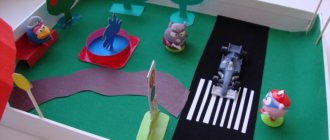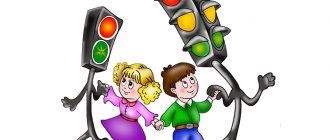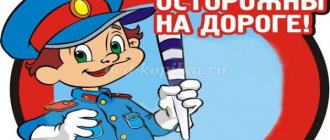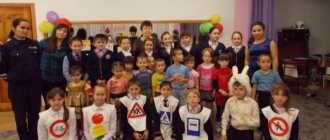Didactic games on traffic rules in the senior group
Preschoolers in the older group already know the rules of behavior on the street; they just need to generalize the knowledge. During games, children develop memory, speech skills, observation, and their spatial orientation improves. It is important to develop discipline in older preschoolers and the desire to follow traffic rules in everyday life.
Rod of Knowledge
The game generalizes preschoolers' knowledge about the correct behavior of pedestrians. The teacher divides the students into 2 teams. To practice, you need to take a toy traffic controller’s baton, or make one yourself.
The leader alternately gives the baton to the players of different teams. The player who received the item must remember the rule of safe behavior for pedestrians. You can't repeat yourself. The team that gives the most correct answers wins.
Example answers:
- the pedestrian must walk on the sidewalk;
- when crossing the street you need to look to the left, then to the right;
- in the absence of a sidewalk, it is permissible to walk along the side of the road towards moving cars;
- Crossing the street is permitted when the traffic light is green;
- You cannot play on the road or in its immediate vicinity;
- You must not cross the road when vehicles are approaching.
Safe streets
The purpose of the didactic game on traffic rules is to form an idea of correct walking and wheeled movement along city streets, consolidating knowledge about regulatory signs.
The board game is intended for 2-3 players. For it you need to prepare a playing field with a schematic representation of city streets, figures of people, road signs, cars, traffic lights. You can buy a ready-made board game, or you can find it on the Internet and print it out.
The teacher distributes signs and symbols across the field. Players disassemble figures of people and cars. Characters and vehicles can be completely different. You can come up with any scenarios. For example, a schoolchild returns home after school, or a truck carries groceries to the store.
Players take turns rolling dice to move characters along the street. If this is a pedestrian, then he is moved by as many cells as there are dots on the die. If a cyclist, the number of “steps” is multiplied by 2. If a motorist, multiplied by 3. A player moving in a vehicle can accept passengers and leave the car in the parking lot. In the latter case, he becomes a pedestrian. When a cube hits an underground passage, the player can immediately, in one move, move to the opposite side of the street. And if you get into an area marked as dangerous, you have to skip a move.
Guess the sign
The game improves visual and auditory perception, teaches preschoolers to remember the visual form of a road sign when mentioned verbally. To play, you need to prepare a lotto with images of different signs, as well as blank sheets of paper the size of the pictures.
The game involves 3-6 children. The teacher lays out the lotto in front of each person and distributes paper. Then he reads out a riddle or part of a poem regarding a specific road sign. The players’ task is to understand what sign is being talked about, find it on the lotto, and cover it with a sheet of paper. The winner is the one who covers all the pictures correctly and faster than his opponents.
Driver
The game consolidates knowledge of traffic rules, improves thinking ability and the ability to navigate in space. It is necessary to prepare several options for playing fields depicting streets with infrastructure and regulatory signs. It is important that the fields allow you to play out different situations on the road. A small toy car is also needed.
The teacher gives the student a task consisting of a series of actions. For example, “go to the clinic, then fill up with gas at the bus station, buy groceries at the store on the way home.” The task in the game is to do everything that is said without breaking the traffic rules. The path begins with an image of a garage or parking lot and should end there.
My street
Do-it-yourself didactic games on traffic rules are very interesting; a teacher can make a model of a street with children. For older kindergarteners, this is an extremely exciting activity. It’s good if the model represents a real street on which the kindergarten is located. All traffic lights, zebra crossings, traffic signs, and vegetation are required. We also need figures of vehicles and pedestrians.
At the first stage of the game, children examine the model made, answer the teacher’s questions, pointing with their finger what they mean or putting the characters in a certain place. What are these questions:
- what buildings are located on the street;
- traffic here is one-way or two-way, how many lanes are there on the road;
- is there an intersection on the street, how to cross it correctly;
- where are the pedestrian crossings, how are they marked;
- where pedestrians walk, where cars drive, is it possible to go out onto the roadway;
- how traffic is regulated, where traffic lights are located;
- is there public transport on the street, what is it for, where are the stops;
- what do the road signs on the street mean?
At the second stage of the game, the teacher asks the students to take turns “driving” and “walking” along the street, observing the rules of safe movement. Children who make no mistakes in completing the task receive a prize.
Visit a children's auto town with your child
Children's auto town is a playground with a mini-version of streets and roads. There is:
- roadway with intersections;
- traffic signs;
- pedestrian crossings;
- speed bumps;
- transport stops;
- railway crossings with barriers;
- traffic lights at which signals are switched.
In motor towns there is a toy fleet: cars, trucks, trams, buses that a child can ride on.
In the motor town, the child learns to cross the road with and without a traffic light, learns how to act correctly in dangerous situations on the road, but does it safely.
Children's auto town opened in Chelny
Auto towns can be found in entertainment centers; they are made in playrooms, lyceums, and driving schools. Parents can buy a ready-made set of items for a car town and make it in the kindergarten or school where the child studies.
A set of items for a motor city costs from 14,000 rubles. Source
Didactic games on traffic rules in the middle group
In the middle group, it is important to reinforce the rules of safe movement on the street. Children need to be introduced to the main road signs and their meanings, and to be taught proper behavior on the road.
Right or wrong
The teacher places figures of characters and vehicles on the playing field depicting the street. The children's task is to tell whether each character acts correctly or incorrectly, and why. If incorrect, players must correct the actions.
Transport
To play, you need to print out images of vehicles. The teacher reads riddles or excerpts of poetry about a specific vehicle, and the children must guess what they are talking about. Whoever names the correct vehicle first gets its picture. The winner is the player who collects the most pictures.
What applies to the passenger?
The presenter calls out a series of words, and the players must clap their hands when the word refers to passenger transport and passengers. For example: tram, ticket, walk, rest, stop, trip, dancing, seat, plane, swimming, conductor.
Traffic Laws
The didactic game “Road Rules” reinforces preschoolers’ knowledge of how motorists and pedestrians should behave towards each other, what signs and symbols to take into account. You need to prepare cardboard sheets. Glue pictures depicting different situations on the road to one side of each cardboard, and a verbal description to the other.
Children look at the pictures and try to explain the situation depicted: whether road users act correctly, taking into account road signs, symbols and traffic lights. Next, the presenter reads out what is written on the sheets so that the players understand whether they answered correctly.
Answer correctly
To play the game you need to make chips. The teacher divides the players into 2 teams. Each group takes turns asking questions and is awarded a chip for the correct answer. The team that collects the most chips wins. Here are the questions for the game:
- Where do pedestrians go? - on the sidewalk;
- How to behave correctly on public transport? - quiet, calm;
- Where should children play? - in the courtyard;
- What colors does the traffic light light up? – red (stop), yellow (wait), green (go);
- When a pedestrian's light is green, which light is on for the driver? - red;
- What is a person who walks called? - a pedestrian;
- Where does public transport stop? - At the stop;
- Is it possible for a small child to cross the road alone? – no, you need to be with an adult;
- Where is it legal to cross the road? – at traffic lights, along pedestrian and underground passages;
- How to get around the bus? - from behind, when he drives away;
- What kind of transport is there? – passenger, personal, land, underground, sea, air.
What does the traffic controller tell us?
The game requires 3 cards depicting a traffic controller gesturing according to traffic signals. And also 3 mugs: red, yellow, green. The player’s task is to match the image of the traffic controller to the correct color of the traffic light.
Non-existent road signs
This is a great conceptual way to develop a child's understanding of the world. Based on simple drawings, the child develops logical thinking, associative perception, and adapts to social life. Road traffic is an integral part of modernity, vehicles and pedestrians intersect everywhere. Understanding the basics of traffic rules means being safe.
Pictures with non-existent road signs are beneficial because they develop in the child an idea of real symbols that need to be followed. At the same time, fantasy develops thanks to imaginary objects. Children easily reproduce or invent new colorful images. This learning process is built in a game format and is preparatory to further study of the signs from the Rules.
Didactic games on traffic rules in the younger group
Kids should understand the names and purposes of vehicles, traffic lights, and main road signs.
Find the extra word
The teacher names 4 words, and the children must say which one is superfluous in meaning. Examples:
- tram, barn, tractor, ambulance;
- swing, excavator, trolleybus, truck;
- boat, boat, bus, yacht;
- scooter, roller skates, bicycle, car.
Traffic light repair
To play, you need a contour image of a traffic light and 3 circles corresponding in size to its “eyes”: red, yellow, green. The teacher explains to the students that the broken device needs to be repaired. Children place circles on the traffic lights in the correct sequence and tell what each color signals.
Collect the sign
To play the game, you need to print and cut into several parts images of road signs familiar to preschoolers of the younger group. It is also necessary to make copies of the pictures that players will use as a guide when folding the cut images. If a child quickly puts together pictures, you can ask him to complete the task without a sample.
Stop or go
For the game, the teacher prepares 2 signal cards - red and green. Hands out steering wheels made of cardboard to children. The teacher explains that when he shows the green card, the players should move as if driving a car. When the green card turns red, you need to brake.
We run across the road
The presenter has 3 cards corresponding to traffic lights. When the green one is raised, children run around the playroom, when the yellow one is shown, they jump or dance in place, and when the red one is shown, they stand still. Those who make mistakes are eliminated. The last player remaining wins.
Garage
Hula hoops are placed in the corner of the playground - these will be cars parked in the garage. There should be 4-8 fewer of them than players. The teacher turns on the music, the children dance. When the music stops, the players rush to the “garage” and hula hoop one at a time. Those who do not have time are eliminated.
Learn poems about traffic rules with your child, make riddles
Just learning and understanding traffic rules can be difficult. And in the form of poetry, it is easier for a child to remember the rules.
Using this poem, the child will remember when it is possible to walk across the road and when not. Source
Riddles will help you remember the concepts used in traffic rules: roadway, sidewalk, underpass, traffic light, railway crossing.
It is more fun and interesting for a child to solve riddles than to answer ordinary questions about traffic rules. Source
Didactic games on traffic rules in the preparatory group
Preschoolers in the preparatory group are preparing for school; they already know about the rules of behavior on the street and in transport, and understand road signs and markings. You just need to consolidate this knowledge. It is also important to pay attention to the speech and mental development of preschoolers.
Find the sign
Children are shown lotto pictures depicting different situations, but without road signs. The players’ task is to find a suitable one among the separately prepared signs and put it in the picture where it should be in reality.
I am a passenger
The teacher shows the students cards depicting different situations in public transport. Players take turns taking pictures, telling what they see: whether the characters are doing the right thing or not, if not, then they explain what they would do.
Name the signs
A couple is playing. Players take turns naming the road signs they know. The one who remembers the most wins.
Crossroads
The teacher introduces students to the types of intersections, shows the corresponding pictures, and tells them how to cross them correctly. Children should learn that intersections can be controlled or unregulated, and their configurations are cross-shaped, T-shaped, Y-shaped, or with a roundabout.
Pictures of road signs
Clear drawings of signs with analogies will help you remember the most important symbols that you will encounter on your way to elementary school or kindergarten. Vivid images and simple explanations allow you to instantly attract attention and convey information quickly, cheerfully and clearly.
Thanks to road pictures, the child learns to be independent and make the right decisions. The main goal is to show that participation in traffic is not as scary as it may seem. If you understand the meaning of road signs, you can organize your own actions.
Road pictures are different for each age category. Children learn in the presence of an adult, who prompts actions and explains signs.






